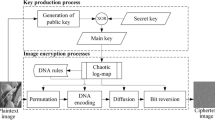Abstract
In today’s world, most of the things are done online such as online banking, food ordering, car booking, and shopping. It is very difficult to protect the data utilizing the conventional cryptographic and Steganographic approach with the present techniques. DNA cryptography is one of the new areas of information security. DNA cryptography can encrypt the data or information in the form of DNA nucleotides (A, T, G and C). In this DNA Cryptography process, the data may be in the form of Audio, video, Image, or text file. It can create utilization of the huge DNA storage capacity and its biological properties like robustness, vastly constant molecule, efficient of cost and simply obtainable. However, the message encryption algorithm contains various steps to break and to obtain the original message. Therefore, in this paper, presents a Trellis algorithm with DNA sequence and random key generation to provide more security to the data. In this process, key is generated randomly between sender and receiver and the arbitrary selection of DNA sequence is enhanced to numerous numbers. The trellis encoding process can be performed to encrypt the data and trellis decoding process is executed to decrypt the data securely. The experimental results of this proposed system can show that this method can resist different kinds of attack. This presented technique can assist to retrieve original data (audio, video, image, or text file) without any alteration from decryption process.








Similar content being viewed by others
Data Availability
Available on request.
Code Availability
Available on Request.
References
Chang, W.-L., Guo, M., & Ho, M.-u. (2005). Fast parallel molecular algorithms for DNA-based computation: factoring integers. IEEE Transactions on Nanobioscience, 4(2), 149–163.
Dhawan, S., & Saini, A. (2012). Secure data transmission techniques based on DNA cryptography. International Journal of Emerging Technologies in Computational and Applied Sciences (IJETCAS), 2(1), 95–100.
Rama Devi, K., & Prabakaran, S. (2016). An enhanced bilateral information security towards a conventional cryptographic system using DNA sequences. Indian Journal of Science and Technology. https://doi.org/10.17485/ijst/2016/v9i39/102067
Beck, M. B., & Yampolskiy, R. V. (2015). Hiding color images in DNA Sequences. In The 26th Modern Artificial Intelligence and Cognitive Science Conference (MAICS 2015), Greensboro, North Carolina.
Zhang, M., Sabharwal, C. L., Tao, W., Tarn, T.-J., Xi, N., & Li, G. (2004). Interactive DNA sequence and structure design for DNA nanoapplications. IEEE Transactions on Nanobioscience, 3(4), 286–292.
Taur, J.-S., Lin, H.-Y., Lee, H.-L., & Tao, C.-W. (2012). Data hiding In DNA sequences based on table lookup substitution. International Journal of Innovative Computing, Information and Control, 8(8), 6585–6598.
Mohammadreza, N., & Nazanin Sadat, K. (2015). A method to encrypt information with DNA-based cryptography. International Journal of Cyber-Security and Digital Forensics (IJCSDF), 4(3), 417–426.
Tornea, T., &Borda, M. E. (2013). Security and Complexity of a DNA-Based Cipher. In 11th RoEduNet International Conference pp. 1–5.
Arita, M., & Ohashi, Y. (2004). Secret signatures inside genomic DNA. BiotechnolProg, 20(5), 1605–1607.
Terec, R., Vaida, M.-F., Alboaie, L., & Chiorean, L. (2011). DNA security using symmetric and asymmetric cryptography. International Journal on New Computer Architectures and Their Applications (IJNCAA), 1(1), 34–51.
Lai, X. J., MingXin, Lu., Qin, L., Han, J. S., & Fang, XiWen. (2010). Asymmetric encryption and signature method with DNAtechnology. Science China Information Sciences, 53(3), 506–514.
Rama Devi, K., & Prabakaran, S. (2015). A survey on DNA cryptography. International Journal of Applied Engineering Research. https://doi.org/10.17485/ijst/2016/v9i39/102067
Rama Devi, K., & Prabakaran, S. (2016). Secure private key exchange in symmetric cryptography using finite field approach(GF2^n). International journal of control theory and applications, 9(17).
Arqub, O. A., & Abo-Hammour, Z. (2014). Numerical soluteon of systems of second-order boundary value problems using continuous genetic algorithm. Information Sciences, 279, 396–415.
Abo-Hammour, Z., Alsmadi, O., Momani, S., Abu Arqub, O. (2013). A Genetic Algorithm Approach for Prediction of Linear Dynamical Systems. Mathematical problems in Engineering.
Abo-Hammour, Z., Abu Arqub, O., Momani, S., & Shawagfeh, N. (2014). Optimization solution of Troesch’s and Bratu’s problems of ordinary type using novel continuous genetic algorithm. Discrete Dynamics in Nature and Society. https://doi.org/10.1155/2014/401696
Funding
No funding supports.
Author information
Authors and Affiliations
Corresponding author
Ethics declarations
Conflict of interest
The authors declare that there is no conflict of interest.
Ethical Approval
This article does not contain any studies with human participants or animals performed by any of the authors.
Additional information
Publisher's Note
Springer Nature remains neutral with regard to jurisdictional claims in published maps and institutional affiliations.
Rights and permissions
Springer Nature or its licensor (e.g. a society or other partner) holds exclusive rights to this article under a publishing agreement with the author(s) or other rightsholder(s); author self-archiving of the accepted manuscript version of this article is solely governed by the terms of such publishing agreement and applicable law.
About this article
Cite this article
Rama Devi, K., Bhuvaneswari, E. An Enhancement in Data Security Using Trellis Algorithm with DNA Sequences in Symmetric DNA Cryptography. Wireless Pers Commun 129, 387–398 (2023). https://doi.org/10.1007/s11277-022-10102-8
Accepted:
Published:
Issue Date:
DOI: https://doi.org/10.1007/s11277-022-10102-8




